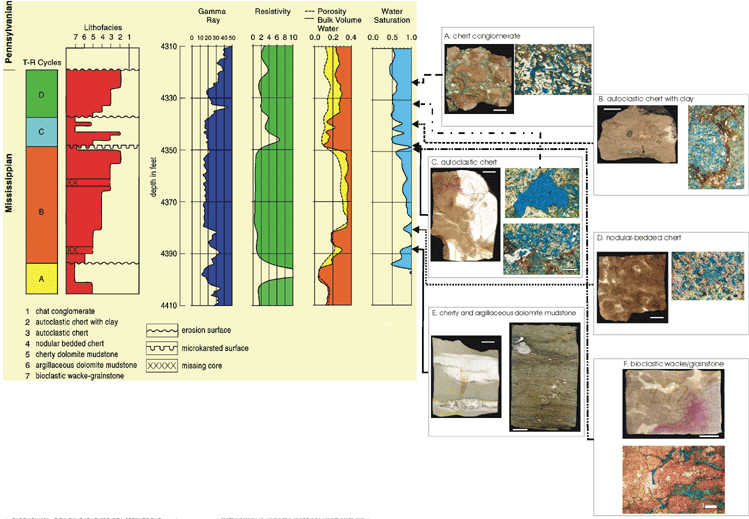
Characterization of Mississippian Osage Chat in South-Central
Kansas
Kansas Geological Survey
Open-file Report 2002-50

|
|
Kansas Geological Survey Open-file Report 2002-50 |

A. Chert conglomerate. Rock slab photo from 4323.5 ft showing chert conglomerate containing clasts of oil-stained chat and chert in silty, clay matrix with smaller chert clasts. Scale bar on all slab photos is 2 cm. Thin section photomicrograph of chert conglomerate from 4322.5 ft from inside chat pebble containing abundant molds of sponge spicule and small vugs filled by blue epoxy. Porous microcrystalline quartz and microcrystalline calcite (stained with alizarin-red) comprise matrix, replaced by patches of megaquartz (white). Irregular vugs cross cut other fabrics. Scale bar on all photomicrographs is 0.1 mm. All photomicrographs taken in plane light and have blue epoxy impregnation.
B. Autoclastic chert breccia with clay. Slab core photo from 4337 ft shows autoclastic chert breccia with clay infiltration below arrow. Interpenetrating clasts of brown porous chat. Thin section photomicrograph from 4398 ft. contains autoclasts that are lined by clay and brown microcrystalline calcite. Abundant microporosity, molds, and vugs in spiculitic microcrystalline chert (chat).
C. Autoclastic breccia. Rock slab photo from 4346 ft containing autoclastic chert breccia with mottled oil staining and fractures. Two photomicrographs, upper photo from 4331 ft centered on shelter porosity developed between clasts of highly porous chat. Section stained with alizarin-red and photographed under plane polarized light. Lower photomicrograph from 4331.5 ft showing boundary between interpenetrating clasts of highly porous chat. Boundaries defined by "dirty" clay rim. Interior of clasts contain varying amounts of microcrystalline quartz and associated fine vuggy and moldic porosity.
D. Nodular bedded chert. Rock slab photo from 4379 ft containing nodules of chat in overpacked fabric with interpenetrating clasts. Variable brown oil staining identify separate clasts associated relative differences in microporosity. Also individual clasts show variations in staining along discontinuous fractures. Photomicrograph from 4379.5 ft from within a chat nodule containing micro-, moldic, and vuggy porosity. Some micritic calcite preserved stained with alizarin-red.
E. Cherty and argillaceous dolomite mudstone. Two rock slab photos with the left photo showing gray-gray dolomite mudstone with white chert nodules (4389 ft). Lower nodule is stained with oil due to presence of microporosity. Photo to right is another example of a cherty, argillaceous dolomite mudstone (4306 ft). It contains burrows, wavy, and lenticular bedding suggesting moderate bioturbation. White rounded and small lenticular-shaped chert nodules suggest selective silicification of burrows.
F. Encrinite wacke-grainstone. Rock slab photomicrograph at 4347 ft showing a contact (at arrow head) between encrinitic grainstone (lower right) and autoclastic chert. Top of encrinite is solution microkarst. Solution cavities are deep, cutting through approximately 0.5 m of core. Contact is also boundary of cycle B. Encrinite is tightly cemented by calcite stained here with alizarin-red. Photomicrograph below the rock slab from 4341 ft from encrinite capping the thin cycle C. Alizarin-red stain helps to distinguish the slightly darker and cloudy crinoid ossicle from the syntaxial calcite overgrowth cement. Unstained patches of replacive microquartz with accompanying microporosity and vugs also shown.
|
|